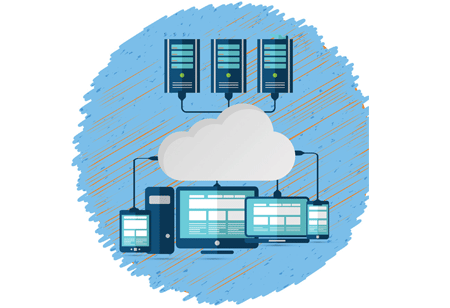
A Cloudy Future: Migrating Legacy Systems & Data To The Cloud


Raghu Radhakrishnan, CEO & MD - India Subsidiary, Tmaxsoft, 0
The innovations of Uber Netflix Tinder and Facebook apps have given the world revolutionary user interfaces and experiences. Their apps and software are nimble changeable and exploit the API economy to link-up with other apps systems and more. Once viewed as out-of-the norm disruptors they are now viewed as the standard for offering customers users and consumers the fast personalized easy and consistent experiences they’ve become accustomed to. As a result many companies are rethinking how they deliver applications and store data to deliver the agility needed to meet user expectations. The question is how to update and modernize them selves to take advantage of innovation?
The Future is in the Cloud
Uber Netflix, Tinder and Facebook are all products of a great frontend, plus modern agile infra-structures and backends that are cloud based. So one thing is abundantly clear. The systems where innovative apps and software live need to be in the cloud. In the case of some of the hottest app startups they have only used the cloud.
Financial technology (fintech) and insurance technology(InsurTech) are among those that have taken slow, outdated and often half manual & half digital processes in their respective industries and made them fast modern, and 100 percent digital. They simply bypassed on premises data centers & main frames and are running their systems from the cloud. For example digital mortgage lenders can promise a loan approval in a few hours. E-insurance companies handle property and casualty claims completely online including sending photos of a damage through an app. The cloud makes this happen.
Companies that have been around since the 20th century now need to step up their games to compete with the startups. Today’s customer is easily persuaded to leave a favorite brand they’ve used for years if the reward is faster, more consistent service via an app or the web. The good news is that providing customers and users with modern, easy-to-use and high performing apps is possible without starting from scratch on a cloud infrastructure and writing all new applications and systems. Sensible options are available, such as mainframe rehosting and database management to migrate what you need to the cloud but keep confidential applications and data safe & secure.
Mainframe Rehosting
Many enterprises have relied on mainframes for years. Hundreds of apps, millions of lines of code, incalculable amounts of valuable and big data reside on these mainframes, and they all keep business running. Thanks to fixes patches spaghetti architecture and slower performance, they are not ideal or even suitable for handling today’s agile workloads or inspiring innovative digital solutions to analog problems.
Mainframe rehosting moves applications to a cloud based environment with no reformatting, code changes or user impact. Rehosting provides the agility, reliability and scalability of an open, modern system on the cloud and the cost savings are substantial. This leaves more resources for innovation, instead of legacy system maintenance.
How does it work? In the case of their hosting solution, mainframe applications are compiled in a modern open system on the cloud without changes to the business logicdata or code. This new environment runs specialized rehosting software that provides t h e development and execution environment required by traditional mainframe programming technology. Once the mainframe application is rehosted, it can continue to function with minimal code changes.
Benefits of Rehosting
With Rehosting solution, enterprises gain a fast, flexible foundation for quickly responding to market change and future integration requirements. Applications are now running in a modern architecture, positioning
an organization for greater agility, growth and competitive advantage. Other advantages include:
•Rehosting can take as little as nine months instead of the three to five years it can take to rewrite or replace the mainframe. Because the process simply moves the mainframe as to open systems or the cloud, there is minimal risk.
•The processes of recompiling and migrating are automated so existing IT organizations can handle the process without specialized training or hiring out sourcers.
•Rehosting delivers a secure, high performance, and flexible environment that dynamically scales based on business demand, so that end users do not have to wait.
•The cost of infrastructure and licensing for a mainframe increases each year. Rehosting removes almost all that expenses without changing how your mainframe assets operate.
These benefits come even more sharply into focus with actual customer examples.
Customer Success with Rehosting
A financial services giant that rehosted its mainframe application, witnessed that the costs of running a portfolio management system fell by 66 percent after rehosting. Another customer, GE Capital eliminated cost inefficiency through rehosting after identifying that 78 percent of its source code was unused. Mark Rubel, Executive Director, Application Development at GE Capital said, “Our platform now supports all the growth our business wants. All the new applications can move forward with what they want to do. I can make data available and I can make it SOA enabled”. A major U.S. retailer reported that rehosting their mainframe applications had no negative impacts on their business. Their 10 mission critical, core business systems ran on the mainframe, so moving smoothly into the new environment was imperative. They also reported that their system operates around the clock and user experience performance has improved. And finally a global insurance company announced that after they rehosted their mainframe, online response time improved to 200 milliseconds.
The customers who saw the most success also took advantage of tools for moving mainframe data to an isolated database tier that supports industry standard SQL databases and a database management system that enables agility and flexibility.
Database High Availability in the Cloud with Next Generation DB
After companies move main¬frame applications and core systems to the cloud, problems can arise if they don’t access data from on-premise data centers and databases. However a relational database management system(RDBMS) is not designed to run on a virtualized platform. Today’s RDBMS bridges the gap between legacy relational databases and running workloads in a cloud environment such as AWS or Microsoft Azure.

Highly compatible with Oracle it provides companies the option of moving database management workloads (and eventually even their databases) to the cloud and a simple licensing model similar to software as a service(SaaS) subscription pricing. It enables a stable and efficient management of DBMSs and guarantees high performance transaction processing.
With rehosting middle ware and next generation cloud DB, enterprises have a solid foundation for the innovation and business agility needed to keep-up with the startups. The solution runs existing mainframe applications in the cloud. There are no changes to standard mainframe technology 3270 screens, web, COBOL, JCL, or DB2. You have the option of replatforming to move older and difficult to-maintain databases to other databases.
•Rehosting can take as little as nine months instead of the three to five years it can take to rewrite or replace the mainframe. Because the process simply moves the mainframe as to open systems or the cloud, there is minimal risk.
•The processes of recompiling and migrating are automated so existing IT organizations can handle the process without specialized training or hiring out sourcers.
•Rehosting delivers a secure, high performance, and flexible environment that dynamically scales based on business demand, so that end users do not have to wait.
•The cost of infrastructure and licensing for a mainframe increases each year. Rehosting removes almost all that expenses without changing how your mainframe assets operate.
These benefits come even more sharply into focus with actual customer examples.
Customer Success with Rehosting
A financial services giant that rehosted its mainframe application, witnessed that the costs of running a portfolio management system fell by 66 percent after rehosting. Another customer, GE Capital eliminated cost inefficiency through rehosting after identifying that 78 percent of its source code was unused. Mark Rubel, Executive Director, Application Development at GE Capital said, “Our platform now supports all the growth our business wants. All the new applications can move forward with what they want to do. I can make data available and I can make it SOA enabled”. A major U.S. retailer reported that rehosting their mainframe applications had no negative impacts on their business. Their 10 mission critical, core business systems ran on the mainframe, so moving smoothly into the new environment was imperative. They also reported that their system operates around the clock and user experience performance has improved. And finally a global insurance company announced that after they rehosted their mainframe, online response time improved to 200 milliseconds.
Rehosting delivers a secure, high performance and flexible environment that dynamically scales based on business demand, so that end users do not have to wait
The customers who saw the most success also took advantage of tools for moving mainframe data to an isolated database tier that supports industry standard SQL databases and a database management system that enables agility and flexibility.
Database High Availability in the Cloud with Next Generation DB
After companies move main¬frame applications and core systems to the cloud, problems can arise if they don’t access data from on-premise data centers and databases. However a relational database management system(RDBMS) is not designed to run on a virtualized platform. Today’s RDBMS bridges the gap between legacy relational databases and running workloads in a cloud environment such as AWS or Microsoft Azure.

Highly compatible with Oracle it provides companies the option of moving database management workloads (and eventually even their databases) to the cloud and a simple licensing model similar to software as a service(SaaS) subscription pricing. It enables a stable and efficient management of DBMSs and guarantees high performance transaction processing.
With rehosting middle ware and next generation cloud DB, enterprises have a solid foundation for the innovation and business agility needed to keep-up with the startups. The solution runs existing mainframe applications in the cloud. There are no changes to standard mainframe technology 3270 screens, web, COBOL, JCL, or DB2. You have the option of replatforming to move older and difficult to-maintain databases to other databases.